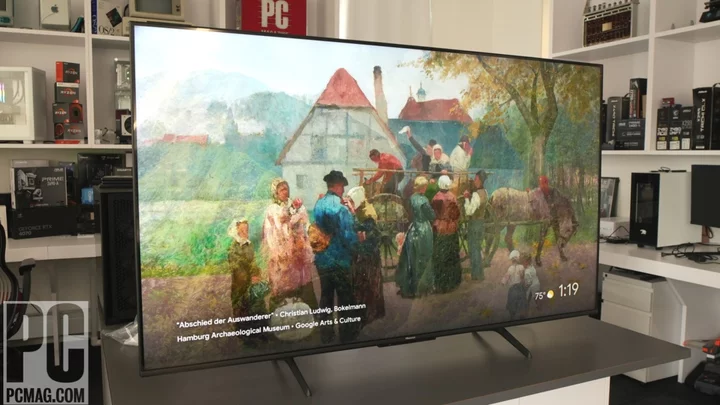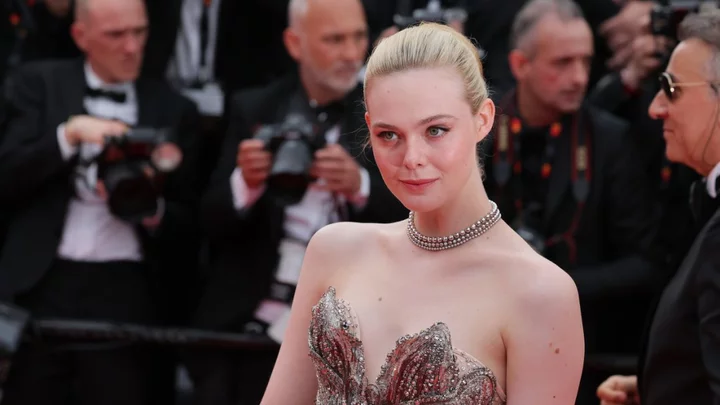Hisense has been consistently producing inexpensive, value-loaded TVs over the past few years, with its U6H earning our Editors’ Choice award for budget TVs in 2022. That model has now been replaced by the U6K, a less expensive set with an even better picture. The U6K costs a reasonable $799.99 for the 65-inch model we tested, but its “everyday pricing” (what it’s actually being sold for in stores) is often $649. Its color levels are generally excellent, its contrast is far superior to the U6H thanks to its mini-LED backlight, and it has much lower input lag than its predecessor. The only real compromise is brightness; if you want a blazingly bright picture, you’ll have to spend at least $1,000 on a higher-end model like the Hisense U8H. For the price and the picture quality, however, the Hisense U6K easily earns our Editors’ Choice award for affordable TVs.
Typical TV Aesthetics
The U6K has a typically unassuming design. It's mostly bezel-less, with a narrow black plastic band running along the sides and top and a thin black strip along the bottom edge holding the Hisense logo. A small, rectangular box sticks out below the center of the strip and holds the power LED, infrared remote sensor, far-field microphones, and a microphone mute switch. The TV stands on two inverted V-shaped legs that can be set near the edges of the screen or closer to the center to accommodate your entertainment center (VESA wall mounts are also supported).
On the back of the TV, facing left, are three HDMI ports (one eARC), two USB ports, a 3.5mm composite video input, a 3.5mm headphone jack, and an antenna/cable connector. A fourth HDMI port, an Ethernet port, and an optical audio output face directly back, slightly further in.
The remote is identical to that of Hisense's older TVs. It’s a long rectangular wand made of black plastic that's slightly wider near the bottom. It has a large, white, circular navigation pad near the top with Google Assistant, input, power, settings, and user buttons placed above the pad closer to the top edge. There's also a pinhole microphone tucked in there. Home, back, and live TV buttons sit below the pad, with volume and channel rockers further down. Dedicated service buttons for Amazon Prime Video, Disney+, Netflix, Peacock, Tubi, and YouTube can be found near the bottom.
Google TV With Hands-Free Google Assistant
Like most Hisense TVs, the U6K uses Google TV as its smart TV platform. It’s a full-featured, capable system that covers all major streaming services including Amazon Prime Video, Apple TV, Crunchyroll, Disney+, Hulu, Max, Netflix, Twitch, and YouTube. Hundreds of other apps and services are also available and you can also stream anything from an Android phone or tablet, Chrome device, iPad, iPhone, or Mac thanks to support for both Google Cast and Apple AirPlay 2.
Google Assistant is built into Google TV, and far-field microphones allow you to use it hands-free by saying, “Hey Google,” followed by a command. It’s a capable voice assistant that can control the TV itself, search for content, answer general questions, provide sports and weather reports, and control connected smart home devices. You can mechanically turn off the microphones with the switch on the bottom edge of the screen if you prefer, but then the indicator LEDs glow yellow. Disabling Google Assistant entirely via the settings is the only way to turn off the yellow LEDs. If the yellow lights bother you, and you don’t mind slight kludge, a strip of black electrical tape will do the trick.
Solid Contrast, Excellent Color
The Hisense U6K is a 4K TV with a 60Hz refresh rate. It supports high dynamic range (HDR) content in Dolby Vision, HDR10, HDR10+, and hybrid log gamma (HLG) formats. It has an ATSC 1.0 tuner, but not ATSC 3.0.
We test TVs using a Klein K-10A colorimeter, a Muridseo SIX-G signal generator, and Portrait Displays’ Calman software. Out of the box, in Theater Day mode with an SDR signal, the U6K shows a peak brightness of 394 nits with a full-screen white field and 554 nits with an 18% white field, with a black level of 0.022cd/m^2. Filmmaker mode with an SDR signal shows a peak brightness of 89 nits with a full-screen white field and 131 nits with an 18% white field, but with an odd caveat: It enables the TV’s ambient light sensor to adjust the backlight, which is an odd choice for a mode intended to offer the closest presentation it can give to the director’s vision. Disabling the light sensor (which we recommend for all users) bumps the mode’s brightness to numbers comparable with the Theater Day mode.
With an HDR signal, the U6K shows a peak brightness of 412 nits with a full-screen white field and 591 nits with an 18% white field. With its 0.015cd/m^2 HDR black level, that gives the U6K a contrast ratio of 39,400:1. This isn’t much compared with brighter, higher-end TVs like the Hisense U8H (1,982 nits peak brightness, 0.01cd/m^2 black level, 198,226:1 contrast ratio) or the TCL 4K 6-Series Google TV (1,189 nits peak brightness, 0.002cd/m^2 black level, 594,597:1 contrast ratio), but its low black level is a big step up from the just-as-bright U6H (588 nits peak brightness, 0.03cd/m^2 black level, 19,608:1 contrast ratio).
The above charts show the U6K’s color levels in Theater Day mode with an SDR signal compared against Rec.709 broadcast standards and in Filmmaker mode with the ambient light sensor disabled with an HDR signal compared against DCI-P3 digital cinema standards. Colors are generally accurate with both signals. The HDR picture, in particular, reaches nearly the full range of the color space with little noticeable drift.
We strongly recommend using Filmmaker mode when watching most produced content, because we noticed an odd quirk with HDR Theater mode. Our tests in that mode showed cyans that leaned toward green to the point that they looked more like seafoam, as well as magentas that skewed warm. For reference, the vast majority of TVs we've tested that have both broad Cinema/Movie/Theater modes and more specific Filmmaker/ISF Calibrated modes demonstrated similar colors between modes. Hisense confirmed that this is a bug that's reproducible. The company is working on a firmware patch to fix it, but for now you should stay away from HDR Theater mode. Fortunately, Filmmaker mode is so good (with automatic brightness adjustments turned off) that it’s more of a minor annoyance than a major complaint.
In Filmmaker mode, the “Lions” episode of BBC Earth’s Dynasties looks excellent. The tawny fur of lions and the greens and yellow-greens of savannah grass appear natural, and the hides of cows are properly dark and not washed out. Fine textures are apparent in bright sun and shade. The picture might look more lifelike with a brighter panel, but this is about as good as a 4K HDR documentary can look on a 600-nit TV.
The low black levels and strong contrast still come through in the party scenes of The Great Gatsby. Black suits look black and not blown out, with their contours and textures easily visible. The whites of lights, balloons, and shirts are well-balanced, even if they don’t pop as much as they do on brighter panels. Skin tones look natural and not tinted or sickly.
HDR nature footage on Spears & Munsil’s Ultra HD Benchmark also looks good, with balanced colors and whites. Video depicting heavy snowfall with almost the entire frame fully illuminated doesn’t look dim or gray, even if it would be brighter on pricier TVs. Black backgrounds behind bright and colorful objects also appear appropriately dark, with no obvious light bloom in a moderately lit test environment.
Low-Latency Gaming
The 60Hz panel on the U6K supports variable refresh rate (VRR) and Dolby Vision Gaming, but not AMD FreeSync or Nvidia G-Sync. If you want a 120Hz TV, you’ll have to spend a bit more for the U8H or U8K. That said, the U6K’s gaming performance is responsive. Using an HDFury Diva HDMI matrix, the TV showed an input lag of just 3.7 milliseconds in Game mode, less than half of the 10ms threshold we use to consider a TV to be good for gaming. That's a massive improvement over the U6H, which measured 11.1ms of lag. Make sure you’re in Game mode when you play games, though, because lag jumps to 103.5ms in other modes.
Good Picture at a Budget Price
At $799.99 for a 65-inch screen, the Hisense U6K is an excellent value. It isn’t the brightest or fastest panel, but its contrast and color are both exceptional, especially for the price. Google TV with hands-free Google Assistant bring lots of useful features and functionality to the table, and its input lag is low enough to please gamers. If you want a brighter picture you’ll have to spend more on the Hisense U8H or the TCL 6-Series. But the U6K's mini-LED backlight system is a solid step up from the U6H and it actually costs less than its predecessor, making it easy to call our Editors’ Choice winner for budget-friendly TVs.









